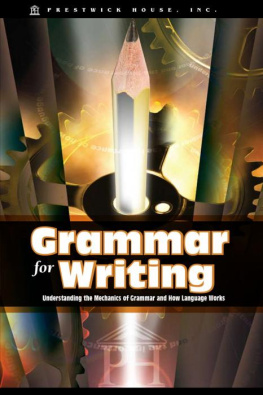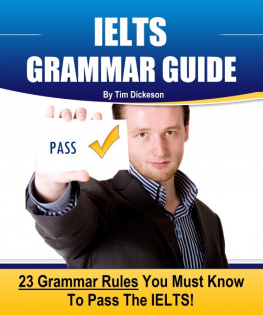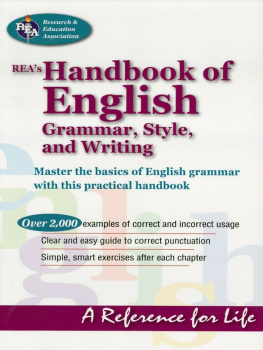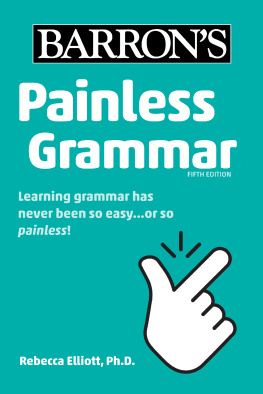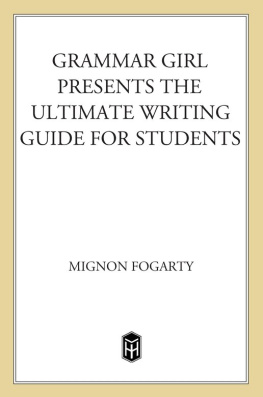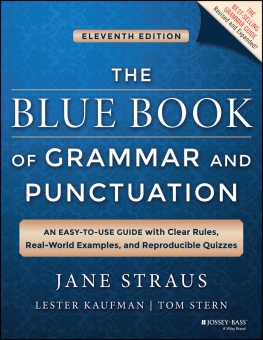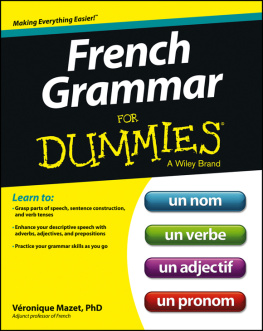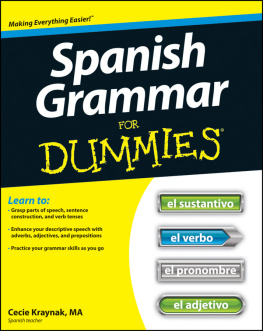The Guide to Grammar: A Student Handbook for Strong Writing By Laura Wilson
Copyright 2015. Laura Wilson. All rights reserved.
Cover Design: Sandra DAntonio
Book Design: Jodi Pedersen
Library of Congress Cataloging-in-Publication Data
Cataloging-in-publication information is on file with the Library of Congress.
Library of Congress Cataloging-in-Publication Data
Wilson, Laura.
The Guide to Grammar: A Student Handbook for Strong Writing /
by Laura Wilson.
pages cm.
Includes bibliographical references.
ISBN 978-1-62521-927-5 (pbk.)
ISBN 978-1-62521-937-4 (ebook PDF)
ISBN 978-1-62521-951-0 (ebook)
1. English languageGrammarStudy and teaching (Middle school)
2. English languageComposition and exercisesStudy and teaching (Middle school) I. Title.
LB1631.W495 2015
428.20712--dc23 2014006943
Maupin House publishes professional resources for K12 educators. Contact us for tailored, in-school training or to schedule an author for a workshop or conference. Visit www.maupinhouse.com for free lesson plan downloads.
Maupin House Publishing, Inc. by Capstone Professional
1710 Roe Crest Drive
North Mankato, MN 56003
www.maupinhouse.com
888-262-6135
Dedication and Acknowledgments
I dedicate this book to an exceptional teacher: my mother, Linda Jacobson, whose grammar, teaching, and writing expertise inspired so many, especially her daughter.
First, I am grateful to have Melissa Slive, Devin Maduras, and Nina Auerbach by my side. These three incredible women make the impossible possible, and they make coming to work every day a joy. Second, to Aemilia Phillips, intern extraordinaire! Aemilias writing creativity, verve, and voice helped add the sparkle to this book. I also want to thank all my students who make teaching a joy, as well as Emily Bloom, Ashley LaRue, Tim OBrien, Brandon Shenkman, RuthAnn Cote, and Annalie Aplin. A special thanks to Karen Soll, Emily Raij, and Lynnette Brent.
Introduction
Every day, you rely on grammar. You tell stories, share ideas, describe foods, give directions, and share your opinions without even thinking about grammar or sentence structure.
Then why can a blank page or computer screen, waiting to be filled with your thoughts, seem so scary at times? Because of gerunds, infinitives, clauses, oh my! Grammar can be intimidating. This book will give you a blueprint for writingsupplying you with easy-to-use tools and easy-to-remember tips that will help you construct strong sentences, allowing you to write anything and everything with skill and confidence! When you start with the basic sentence and learn how to add key grammar strategies and important elements of style, your writing will become as fluent and engaging as any story you tell aloud.
This book is meant not only to introduce you to the patterns found within writing but also to explain some basic (but essential) rules of grammar in a not-a-horrible-lesson-in-grammar type of way, so that you (pronoun) will (helping verb) do (verb) well (adverb) at (preposition) writing (noun)!
Good writing goes far beyond simply applying the rules of grammar. To be effective, writing must be clear, descriptive, interesting, and persuasive. After learning how to use these simple tools, you will effortlessly begin linking words into amazing sentences, sentences into paragraphs, and paragraphs into essays, stories, books, and more! Then that blank page that was once daunting will become exciting and invitingwaiting to be filled with your fantastic writing!
How to Use This Book
This book translates confusing grammar jargon and complex explanations into clear, concise, and memorable descriptions for middle school students. Starting with the simple sentence structure and the fundamental parts of speech as a foundation, students will learn to develop their writing by identifying and utilizing the key grammatical tools that build strong, confident writers.
Each chapter contains simple-to-understand explanations that illustrate essential grammatical rules. The book is divided into three sections: Chapter 1: The Foundation, Chapter 2: Building a Great Sentence, and Chapter 3: Finishing Touches. This organization logically takes the student, step by step, through the process of crafting powerful, dynamic sentences. Accompanying practice sheets (with answer keys ) provide essential practice, and the Nuts and Bolts Grammar Reference Guide offers easy-to-remember tips in one convenient list.
Many students are afraid of writing. They look at a blank sheet of paper or an empty computer screen and panic, not knowing where to start, what to write, or how to express themselves. This book helps students get their ideas on paper clearly and eloquently. Even hesitant students will learn to quickly create sentences that are interesting and thought provoking, resulting in a well-written, standout body of work.
There are two ways to use this book:
1. Use this book as a handy reference guiderefer to specific chapters and lessons for grammar rules to apply when writing, and reinforce skills learned with the supplemental practice sheets.
2. Review the book chronologicallyeach chapter builds on the next. Start with learning how sentences are constructed (using parts of speech). Follow this up with learning how to modify a sentence and to turn the simple sentence into a compound, complex, or compound/complex sentence. End with focusing on elements of style and turning sentences into cohesive, dynamic writing.
As a final note, this book aligns with the new Common Core State Standards for English Language Arts for fifth through eighth grade, serving as a resource to both teachers and students.
Your Grammar Toolbox: A No-Nonsense Reference Page
Just as you need tools to build a house, you need the parts of speech to build a well-constructed sentence. Below are the grammatical tools that will help you build strong sentences.
The parts of speech are words that construct sentences:
1. Nouns: People, places, or thingsthe subject of the sentence (See page 10.)
2. Pronouns: Substitutes for nouns (I, he, she, they, it, etc. ) (See page 12.)
3. Adjectives: Descriptions of nouns or pronouns (See page 34.)
4. Verbs: Action words (See page 18.)
5. Adverbs: Descriptions of verbs or adjectives, usually ending in -ly (See page 36.)
6. Conjunctions: Joining or linking words (and, or, but, nor, etc. ) (See page 45.)
7. Prepositions: Little words that give position (See page 39.)
8. Interjections: Words or phrases used to exclaim, protest, or command (See page 41.)
To build something special within your writing, you will also need:
Transitions: Link ideas and allow the reader to prepare for a reversal or continuation in thought (See page 75.)
Comparisons: Usually involve as or than and have to be equal on each side (See page 49.)
Phrases: Wannabe sentences that just arent quite theresuch as a group of words, without a subject or a verb, that functions in a sentence as a single part of speech (See page 27.)
Clauses: Groups of words with their own subject and verb; some clauses can stand alone (independent) and some cant (dependent) (See page 29.)
Modification: One or more words that give other parts of the sentence more specific meaning (See page 42.)
Punctuation: Road signs or marks, such as the semicolon, the comma, and parentheses, used in writing to separate sentences and elements and to clarify meaning (See page 55.)






